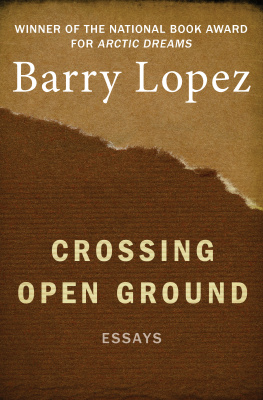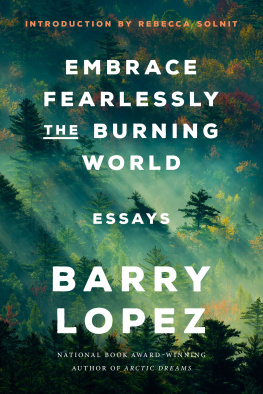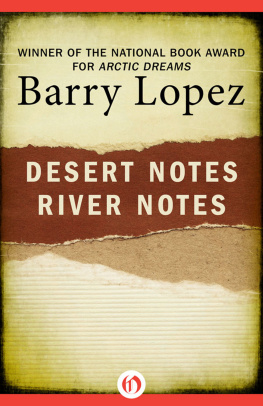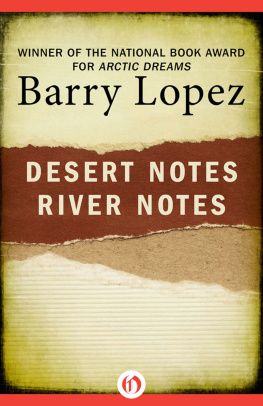OUTSIDE
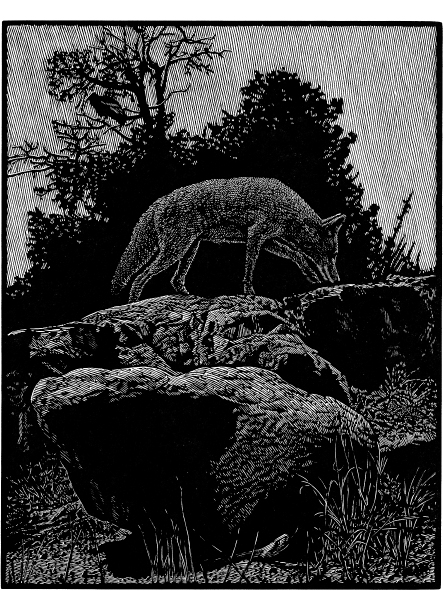



Contents

BARRY LOPEZ HAS BEEN publishing short stories and essays in distinguished literary magazines for nearly forty years. The relationship between landscape and the imagination is a central concern in his work, as is the role of storytelling in bringing communities into healthy relations with the land. The essay Landscape and Narrative (1984) resonates deeply with the aims and methods of the stories in Outside. The essay opens with a gathering of hunters in Anaktuvuk Pass, in the Brooks Range of Alaska. Lopez sits among a group of men listening to hunting stories, and he is particularly taken with the stories of wolverines. One mans story of an astonishing encounter between a hunter on a snow machine and an intelligent wolverine dominates the opening, but the effect of the wolverine stories on the group of listeners is even more astonishing: The landscape seemed alive because of the stories. It was precisely these ocherous tones, this kind of willow, exactly this austerity that had informed the wolverine narratives. The stories make the landscape come alive because they have truthfully evoked the landscape in its particulars. That is the physical landscape, which Lopez calls the external landscape or exterior landscape in the essay. Another landscape is the internal or interior one, and it might be called a spiritual landscape or mental landscape. For Lopez, as for traditional indigenous storytellers, the truth of the story and the value of the storyteller rest in the unimpeachable authority and integrity of the external landscape, which the Navajo say exhibits a sacred order. If the story is successful, it brings the external landscape and the internal landscape into harmony, creating a sense of well-being in the listener and healing any disharmonies in the internal landscape. For Lopez, storytelling connects directly to spiritual rituals and ceremonies of traditional indigenous people, and the qualities of storytelling he values most focus on the role of the storyteller in forging a healthy community living in a healthy landscape.
The six stories gathered here show the growth of a storyteller. The collections Desert Notes (1976) and River Notes (1979) are closely linked to one another, and they give us a strong sense of Lopez as a young writer, since many of the stories date from the early to mid-1970s. Field Notes (1994), closer in chronology and form to the collection Winter Count (1981), is the work of an accomplished writer of prize-winning fiction and nonfiction. Even as a young writer, however, Lopez clearly avoids the role of the romantic, isolated artist. His contact with indigenous storytellers reinforces his sense of the writer as serving the cultural memory of a community, reminding us how to live a decent life, how to behave properly toward other people and toward the land. The name he provides for this figure of the storyteller in Arctic Dreams (1986) is isumataq... a person who can create the atmosphere in which wisdom shows itself.
Wisdom is not owned by any person or culture or language. In defining its outlines in Arctic Dreams, Lopez imagines a scene in which such wisdom might show itself. I could easily imagine some Thomas Mertonlike person, the estimable rather than the famous people of our age, sitting with one or two Eskimo men and women in a coastal village, corroborating the existence of this human wisdom in yet another region of the world, and looking around to the mountains, the ice, the birds to see what makes it possible to put it into words. The figures in Lopezs imagined scene form in effect a group of estimable storytellers from different cultures and traditions. Their goal is first to bind their human wisdom into the land with words and, second, to use their words to bind their human communities together with the land. Storytelling embodies, then, a conversation with the land, and in its most elevated and authentic form it combines the empirical, aesthetic, and spiritual landscapes.
Like the Inuit isumataq, Thomas Merton (19151968) figures the wisdom that shows itself through storytelling. Lopez considered becoming a Trappist monk and in November 1966 stayed at the abbey of Gethsemani in Kentucky, Mertons monastic home. He was especially attracted to the combination of physical labor and spirituality, to the contemplative life. For Lopez as a young man, the contemplative life involves the risky decision to become a professional writer. It is with a sense of vocation, then, that Lopez quotes Mertons The Wisdom of the Desert (1960) near the beginning of Desert Notes: With the Desert Fathers you have the characteristic of a clean break with a conventional, accepted social context in order to swim for ones life into an apparently irrational void.
The stories in Outside break from convention with a great enthusiasm for experimentation. The first-person narrators are so persuasive that readers are sometimes fooled into thinking that they represent Lopez himself. The early fictions do not employ conventional characterization, action, plot, conflict, or resolution. The narrators of Desert Notes, The Search for the Heron, and Within Birds Hearing resemble one another in their physical and spiritual journeys across the landscape. They encounter animals, sometimes in extraordinary ways that may recall the wolverine in Landscape and Narrative. They place their faith in the landscape, in what the landscape can teach them, in the beauty and wonder of the land. They are often solitary, isolated from any social context, but they are not alone.
In the other three stories, the first-person narrators focus on human communities, both in their weakness and in their potential strength. Twilight begins and ends with the narrator seated upon a storm pattern rug woven out of the mind of a Navajo woman, Ahlnsaha. The first half of the story details the numerous owners of the rug from 1934 to 1966, each of whom becomes progressively less certainor truthfulabout the tribal origin of the art or what its proper function should be. The second half of the story evokes, in present tense, the narrators visions as he sits on the rug at twilight, the best time to see what is happening. In contrast to the lies told by salespeople in the first part of the story, the narrators fleeting visions deliver momentary truths. The visions mix images of nature and culture as the narrator works through the senses of sight, hearing, and smell. The visions deliver an ambiguous sense of truthsometimes promising much, sometimes little. In hearing the flight of the gray eagle over the desert, however, the listener becomes exquisitely intimate with the landscape. In creating that sense of intimacy in the reader, Lopez works powerfully on a personal level and creates yet another sense of intimacy.
By such writing, we come to accept that magical transformations join human beings to the landscape and to one another. The narrator of The Falls accepts as fact that his unnamed friend is a shamanistic shape-shifter who can become part of the landscape. The narrators intimacy with his friend allows him to tell of the mans vision quest in the Crazy Mountains as if he were himself part of the mans journey. The man visits the narrator occasionally, at ten-year intervals, but even when the narrator misses a visit he can sense his friends presence. At the climax of these repeated visits, the narrator witnesses the mans leap from the falls, and he implies that the man becomes a salmon as he dives into the water.
Next page




